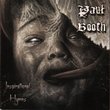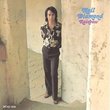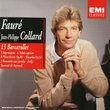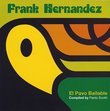| All Artists: Jacques Offenbach, Peter Maag, Gabriel Bacquier, Heather Harper, Mady Mesplé, Nino Falzetti, Noemi Souza, Radmila Bakocevic, Sándor Kónya Title: Offenbach: Les contes d'Hoffmann Members Wishing: 0 Total Copies: 0 Label: Opera D'oro Original Release Date: 1/1/1970 Re-Release Date: 2/5/2002 Album Type: Live Genre: Classical Style: Opera & Classical Vocal Number of Discs: 2 SwapaCD Credits: 2 UPC: 723724346420 |
Search - Jacques Offenbach, Peter Maag, Gabriel Bacquier :: Offenbach: Les contes d'Hoffmann
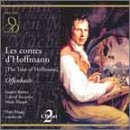 | Jacques Offenbach, Peter Maag, Gabriel Bacquier Offenbach: Les contes d'Hoffmann Genre: Classical
|
Larger Image |
CD DetailsSimilar CDs
|
CD ReviewsSoaring Konya Leads First-rate Traditional Performance L. E. Cantrell | Vancouver, British Columbia Canada | 03/03/2003 (4 out of 5 stars) "Opera D'Oro specializes in bargain-priced recordings of live opera performances. As their quality ranges from splendid to abysmal, buying any of these recordings should be on a buyer beware basis. That said, this 2-CD set is very much one of their better efforts.Like most live recordings, this one suffers from yahoos in the audience who are physically incapable of shutting up when the music starts. Audience members at this performance, thankfully, do tend to hold their applause until individual pieces of music come to an end. Orchestral sound is a bit constricted by standards of our DDD era but the voices are clearly caught. Offenbach died prior to the completion of this, his one seriously-intended opera. As a consequence, the opera has no universally accepted form. Musical historians are of the opinion that Offenbach intended the Opera Comique format of songs punctuated by long patches of spoken dialogue. Les Contes d'Hoffmann is based on a long-forgotten play that was structured in such a way that the intended order of the opera is deduced to have been prologue--dancing doll--dying soprano--Venice--epilogue. In the course of cobbling together a playable piece out of Offenbach's sketches, 19th and early 20th Century impresarios hired lesser musicians to set spoken words to music, sometimes to themes by Offenbach but as often as not out of thin air. Scholars have decided that some music, most notably the fine "Scintille diamant" aria in the Venice sequence has been imported without authority from other Offenchiana. As for the Barcarolle, whether for two, four, six or eight voices--heaven only knows how or where that should be placed in the opera.From some reason, contemporary conductors have become oddly subservient to scholarship rather than musicianship. "Scintille diamant" has been cast forth from some recordings. In many contemporary performances, Act III is set in Venice, despite the fact that the dying soprano sequence provides a far-stronger musical ending to the three tales. The role of Hoffmann's gender-questionable companion/muse, Niklausse, has been assigned to both mezzos and baritones. Then there is (are) the villain(s). Does Hoffmann have one enemy or four? And his woman (women)? Again, one or four? Of contemporary recordings, the Domingo-Sutherland-Bonynge recording should have been a classic. It uses one villain and one beloved, but it is disfigured by dreary deserts of dialogue. (Just try listening to it after the first hearing without grinding your teeth!)This performance dates from a time prior to the onset of scholarly piffle. It offers a format settled upon in the first decade of the 20th Century. It includes "Scintille, diamant", sung recitatives, an acceptable location and suitable voices for the Barcarolle. Hoffmann visits Venice in Act II as he should. Niklausse, wearing pants or not, is a woman. Poor Hoffmann is bedeviled by one villain under four names. On the other hand, his lady love is subdivided. This version is not in the least authentic but it is dramatically and musically effective. It is probably close to what Offenbach, the very definition of a practical theater man, would have turned out had he lived to see a few performances of his last and greatest work.The cast is a very strong one, led by the great Sandor Konya. Konya was a famous Wagnerian--possibly the finest of all recorded Lohengrins. That he even attempted a role so utterly un-Wagnerian is amazing; that he handled Hoffmann's painfully high tessitura so triumphantly is astounding. If his French is less than Parisian, his soaring vocal line is wonderful. Gabriel Becquier as Linndorf, etc., sounds as French as canard a l'orange and sings a menacingly elegant vocal line, as one expects from such an old pro. If none of the women is quite up to the all-conquering Joan Sutherland, they are nevertheless very good. The conducting is appropriate, fluent and propulsive.I give this recording four stars because it is an excellent performance of the traditional version of Les Contes d'Hoffmann by a first-rate cast. I did not give it the fifth star out of exaggerated concern for those delicate souls suffering from the delusion that listenable recordings commenced with digital technology." Oh yes indeed Wayne A. | Belfast, Northern Ireland | 06/06/2005 (5 out of 5 stars) "The gentleman from Canada, being good and wise and just as all Canadians are (like all my grandparents), scores magnificently. I'll give it five stars, what the heck, but I'll warn the noise is, as the gentleman said, a bit much. Not the audience noise but the galumphing about on the stage by the cast (unless the audience rushed the stage somewhere in Act 1--perhaps a cast member dropped a coin). I'd blame bad microphone placement or something; maybe the fact that water down there drains counter-clockwise.
Anyway, it's almost just plain laughable, like a Hoffnung Concert or a Peter Schickele show or the Boston Symphony during the last thirty years. At times it sounds like several hundred singers, all wearing galoshes, diving boots, and buckets full of dried concrete, are "scurrying" around trying to either catch a mouse or form up into the Rotary Club logo. The show sounds great but I'll wager the blocking was atrocious. I think I heard at least one flustered Argentinian shout (with impressive authority in his voice) at the cast in flawless upper-crust 1970-vintage Argentinian "Ruhe! Sitzen machen! I kann nicht die Musik horen!" It may have been the conductor, Herr Maag, or perhaps an elderly guest of the state who was once accustomed to getting his way. I'll say this though, a lot of these Opera d'oro (either Italian for "Italian Wristwatch" or French for "Tasty Cookie"--I'll look it up later) recordings are something else. I tried the Furtwangler Freischutz (with a side of red cabbage and a glass of Pilsner) and loved it, and the Russian Boris Godunov with Pirogev is extraordinary unless you're dieting and are avoiding heavy sauces. Same goes for the Classica d'oro catalogue. I'd just recommend they drop their prices just a hair to Naxos or below level. This stuff ain't gonna get front rack space at the mall." |

 Track Listings (13) - Disc #1
Track Listings (13) - Disc #1